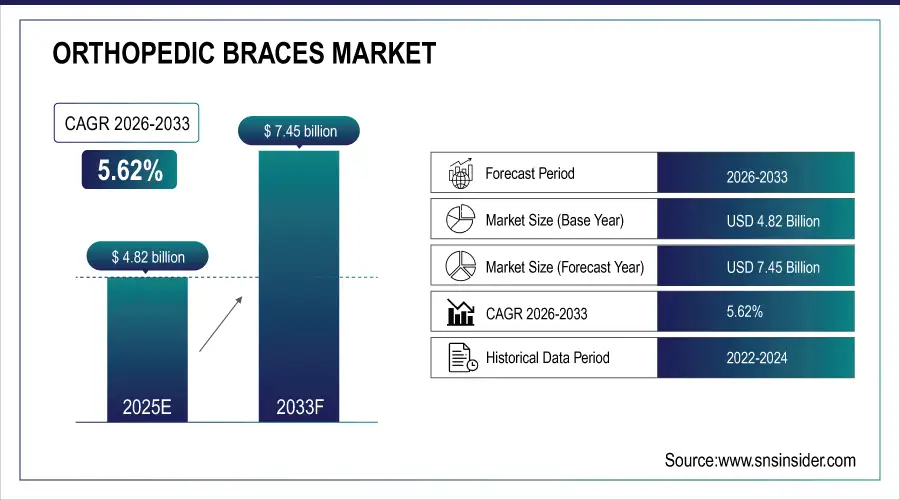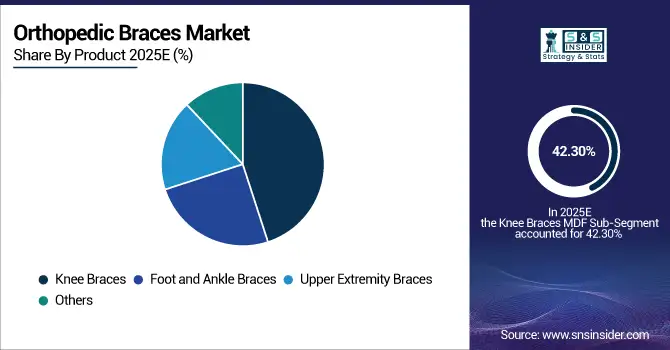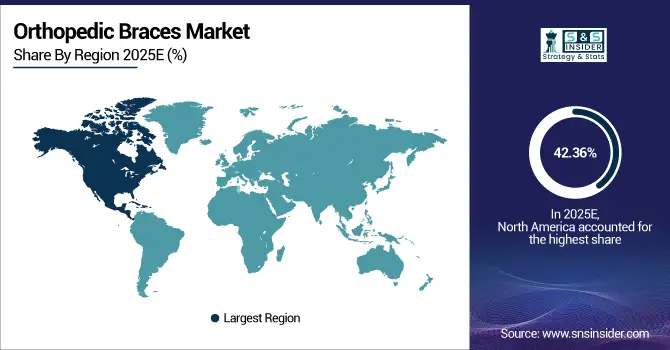Orthopedic Braces Market Report Scope & Overview:
The Orthopedic Braces Market size is valued at USD 4.82 Billion in 2025E and is projected to reach USD 7.45 Billion by 2033, growing at a CAGR of 5.62% during 2026-2033.
The Orthopedic Braces Market analysis highlights the increasing number of musculoskeletal disorders and sports-related injuries is considered as one of the key growth factors for this market. Rising consumer preference for prevention orthopedic care and rising geriatric population also helps in driving the market demand.
Over 1.71 billion people globally live with musculoskeletal conditions like osteoarthritis and back pain—making them the leading cause of disability worldwide
Market Size and Forecast:
-
Market Size in 2025E: USD 4.82 Billion
-
Market Size by 2033: USD 7.45 Billion
-
CAGR: 5.62% from 2026 to 2033
-
Base Year: 2025
-
Forecast Period: 2026–2033
-
Historical Data: 2022–2024

To Get more information on Orthopedic Braces Market - Request Free Sample Report
Orthopedic Braces Market Trends
-
Rising demand for 3D printed orthopedic braces for the custom fit to enhance comfort, accuracy and post-operative outcomes.
-
Increasing demand of lightweight, breathable and flexible brace materials for improving patient compliance and long-term usability.
-
Growing adoption of smart and sensor-incorporated braces for real-time motion tracing and rehabilitation monitoring.
-
Increased availability of orthopedic support products through the rise of e-commerce and online distribution channels.
-
Increasing demand for preventive orthopaedic care and pain management without surgery fuelling continued market growth worldwide.
The U.S. Orthopedic Braces Market size is valued at USD 1.39 Billion in 2025E and is projected to reach USD 2.12 Billion by 2033, growing at a CAGR of 5.39% during 2026-2033. Orthopedic Braces Market growth is driven by increasing sports injuries and an aging population. Rising incidence of musculoskeletal disorders and post-surgical rehabilitation stimulate demand. Material and design progress of the braces contributes to the comfort of patients and beneficiary to his recovery.

Orthopedic Braces Market Growth Drivers:
-
Rising Musculoskeletal Disorders and Sports Injuries Driving Orthopedic Braces Adoption
Increasing prevalence of musculoskeletal disorders including fractures, ligament tears, and osteoarthritis is favoring orthopedic braces market growth. Growing trend of sports participation and increase in number of injuries amongst the athletes and youngsters are other add on to the demand for these. However, non-invasive orthopedic braces can take pain away, stabilize the injury and promote a speedy healing process. Moreover, increasing geriatric population that is susceptible to bone/joint problems further sync the global demand for supportive and rehabilitative braces.
Osteoarthritis affects over 595 million people globally (7.6% of the world population), with knee OA being the most common—driving demand for unloader and supportive braces
Orthopedic Braces Market Restraints:
-
High Cost and Limited Reimbursement Policies Hindering Market Accessibility
The price is expensive that unaffordable to low-income areas for customized and advanced technology based orthopedic braces. Poor health coverage from medical insurance companies also limits patient access, including preventative or non-surgical care. Limited awareness in developing countries as well as the presence of cheaper substitutes such as generic braces also impede growth. Pain, discomfort during extended wear and required replacement often lead to patient non-compliance thus limiting clinical utilization.
Orthopedic Braces Market Opportunities:
-
Technological Advancements and Smart Bracing Solutions Creating New Growth Avenues
Orthopedic braces that incorporate smart technologies including sensors and AI-supported monitoring systems, offer substantial growth opportunities. These advances allow for live monitoring of patient recovery and adjustments in personalized therapy. Use of lightweight material and 3D printed components can also facilitate patient specific designs providing improved comfort and compliance. Growing attention for preventive care, digital health collaborations and tele-rehabilitation support global expansion of the next-generation orthopedic bracing solutions in the healthcare market.
In 2025, over 35% of orthopedic clinics in the U.S. and EU piloted smart braces with embedded sensors to track joint angle, usage, and compliance in real time
Orthopedic Braces Market Segment Analysis
-
By Product, Knee Braces dominated the Orthopedic Braces Market with a 42.30% share in 2025, while Foot and Ankle Braces emerged as the fastest-growing segment, registering a CAGR of 8.90%.
-
By Application, Ligament Injury accounted for the largest market share at 36.80% in 2025, whereas Post-Operative Rehabilitation exhibited the fastest growth, expanding at a CAGR of 10.16%.
-
By Type, Soft & Elastic Braces led the market with a 48.70% share in 2025, and Hinged Braces are projected to grow the fastest with a CAGR of 9.40%.
-
By End-User, Hospitals & Surgical Centers dominated with a 46.20% share in 2025, while Orthopaedic Clinics are anticipated to record the highest growth rate, at a CAGR of 9.70%.
By Product, Knee Braces Leads Market While Foot and Ankle Braces Registers Fastest Growth
Knee braces dominate the market in 2025, and it is their wide popularity for post-surgery recovery and sports injury treatments, as well as for arthritis management. Their capacity to stabilize and protect against recurrence has made them indispensable in the rehabilitation process. Meanwhile, foot and ankle braces are estimated to be the fastest growing segment as a result of rising incidence of sprains, fractures and diabetic foot ulcers coupled with increasing penetration in sports and physical therapy sector.

By Application, Ligament Injury Dominate While Post-Operative Rehabilitation Shows Rapid Growth
Ligament Injury segment dominated the market in 2025 owing to sports induced trauma and growing geriatric population who are susceptible to joint instability. Orthopedic braces provide specific support and compression to damaged ligaments to help hasten recovery. Post-operative rehabilitation braces are experiencing robust growth owing to their efficiency in ensuring joint alignment, promoting mobility and reducing recovery time following surgeries, particularly of orthopedic and spinal nature in hospitals and specialized rehabilitation centers.
By Type, Soft & Elastic Braces Lead While Hinged Braces Registers Fastest Growth
Soft and Elastic braces accounted for leading market share in 2025 as they are more comfortable, flexible and cheaper option for mild to moderate orthopedic conditions. These are great for day use and light support. While, hinged braces are projected to register the fastest growth as they provide better stability and range-of-motion control, and offer protection during post-surgical recuperation & sports activities for moderate-to-severe musculoskeletal injuries that require greater joint support with restricted movement.
By End-User, Hospitals & Surgical Centers Lead While Orthopaedic Clinics Grow Fastest
In 2025, hospitals & surgical centers held a major share in the orthopedic braces market as they carry out high volume of surgeries and post-surgical care that needs braces to recuperate. Better infrastructure and easier reach to advanced care are facilitating increased use. While, orthopedic clinics segment is growing at a rapid pace on account of rising outpatient visits, provision for specialized musculoskeletal care and preference for noninvasive treatments as well as rehabilitation programs thus, making clinics the key contributors in market growth in urban and semi-urban areas.
Orthopedic Braces Market Regional Analysis:
North America Orthopedic Braces Market Insights
In 2025 North America dominated the Orthopedic Braces Market and accounted for 42.36% of revenue share, this leadership is due to the well developed health care infrastructure, high expenditure on health, presence of major manufacturers. Increasing sports, and lifestyle related injuries and increasing cases of osteoarthritis serve as significant demand. In the U.S and Canada there is strong brace protection. 24Technological advances, including 3D printed and lightweight materials have led to better patient compliance.

Get Customized Report as per Your Business Requirement - Enquiry Now
U.S. Orthopedic Braces Market Insights
The U.S orthopedic braces market is the world leader by a wide margin, in large part due to strong awareness and advanced rehabilitation as well as a high number of sports injuries. Strong demand is generated by the high incidence of musculoskeletal disorders, obesity and aging-related joint problems.
Asia-pacific Orthopedic Braces Market Insights
Asia-pacific is expected to witness the fastest growth in the Orthopedic Braces Market over 2026-2033, with a projected CAGR of 6.20% due to strong prevalence of sports injuries and growing elderly population are driving the growth in Asia-Pacific. Asian countries such as India, Japan and South Korea are also significant contributors on account of increasing traction for preventive orthopedic treatment. Support from regional manufacturing developments and availability of low-cost products is fueling industry demand.
India Orthopedic Braces Market Insights
The India orthopedic braces market is driving due to increasing sports injuries, orthopedic ailments and road accidents. Growing awareness of preventive care, rehabilitation and post-surgical recovery is driving demand. Domestic manufacturers are producing cheap, high-quality braces, making them accessible to both urban and rural areas.
Europe Orthopedic Braces Market Insights
In 2025, Europe emerged as a promising region in the Orthopedic Braces Market, due to increasing orthopedic surgeries as well as sport injuries. Germany, France and UK are significant contributors because of the well established healthcare systems. Growing elderly population coupled with rising focus towards minimally invasive recovery solutions will foster the industry demand. Initiatives from the government to increase mobility care and rehabilitation services also promote demand.
Germany Orthopedic Braces Market Insights
Germany is the key orthopedic brace market in Europe with strong healthcare infrastructure and early adoption of advanced rehabilitation technologies. The nation has a high incidence of orthopedic injuries and sports in the ageing population as well as in sports persons.
Latin America (LATAM) and Middle East & Africa (MEA) Orthopedic Braces Market Insights
The Orthopedic Braces Market is experiencing moderate growth in the Latin America (LATAM) and Middle East & Africa (MEA) regions, due to the increase in awareness regarding musculoskeletal health and higher healthcare expenditure. Major regional players are Brazil, Mexico, South Africa and Saudi Arabia. Growing demand is fueled by growing orthopedic care infrastructure and increased use of economical braces. But insurance coverage is inadequate and affordability low in areas.
Orthopedic Braces Market Competitive Landscape:
DJO, LLC is a leading global provider of orthopedic devices with more than 1,000 products that provide solutions for prevention, treatment and rehabilitation challenges in every major anatomical joint. It is a specialist of knee braces, ankle supports and rehabilitation wraps for sports and post-surgery recovery. A highly diverse distribution network includes orthopaedic clinics, hospitals and consumer retail. Increasing sports injuries and an ageing population demanding less invasive support solutions are fuelling demand for its braces.
-
In January 2024, DJO launched the DonJoy ROAM Advanced Knee Brace with enhanced joint-unloading technology to aid osteoarthritis patients, offering superior mobility, comfort, and support, thereby strengthening its presence in the orthopedic braces and rehabilitation market segment.
Zimmer Biomet is a leading innovator in musculoskeletal health care that has a comprehensive orthopaedic product portfolio of braces and supports. The business combines recognition in implants and digital technology with bracing, as part of wider patient-care pathways. knee, foot & ankle and upper extremity braces Support of rehabilitation, sports medicine and joint-care programs with bracing products. Zimmer Biomet has global clinical applications in hundreds of thousands of patients worldwide.
-
In January 2025, Zimmer Biomet acquired Paragon 28 for $1.1 billion, significantly expanding its foot, ankle, and trauma portfolio while enhancing innovation, product diversification, and global competitiveness within the orthopedic braces and mobility solutions market.
Medtronic is active mainly in spinal and orthopaedic surgical devices, and mention of consumer-bracing products is less evident in its public data. The company's offering includes not direct marketed orthopedic braces but technologies related to minimally invasive surgical procedures, spinal fusion and disc-replacement. Although not a bracing-company per se, Medtronic's wide orthopaedic device presence will permit it to sway the rehabilitation-support ecosystems in which braces can complement implants.
-
In February 2025, Medtronic acquired nano-surface technology from Nanovis to enhance osseointegration in its orthopedic and spinal implants, strengthening its device ecosystem complementing post-surgical bracing solutions.
Stryker Corporation is one of the world's leading medical technology companies, offering innovative products and services in Orthopaedics, Medical and Surgical, and Neurotechnology and Spine. Although Stryker is best known for joint & extremities implants, its focus on foot & ankle, knee systems and recovery pathways synergizes with orthopedic bracing markets. The company’s pull helps encourage growth in the market for braces associated with joint replacement and trauma care.
-
In March 2025, Stryker unveiled the next-generation MAKO SmartRobotics at AAOS 2025, broadening its robotic platform to include spine and shoulder procedures, reinforcing its leadership in precision-driven orthopedic technologies and minimally invasive surgical advancements.
Orthopedic Braces Market Key Players:
Some of the Orthopedic Braces Market Companies are:
-
DJO, LLC
-
Zimmer Biomet
-
Medtronic
-
Stryker Corporation
-
Össur
-
Integra LifeSciences Corporation
-
Globus Medical
-
OTTOBOCK
-
AC Mould Engineering Limited
-
Johnson & Johnson Services, Inc
-
BSN medical
-
Becker Orthopedic
-
OPPO MEDICAL INC
-
Langer Biomechanics
-
Frank Stubbs Company Inc.
-
DeRoyal Industries, Inc
-
Ascent Meditech Limited
-
Alcare Co., Ltd
-
3M Company
-
Bauerfeind AG
| Report Attributes | Details |
|---|---|
| Market Size in 2025E | USD 4.82 Billion |
| Market Size by 2033 | USD 7.45 Billion |
| CAGR | CAGR of 5.62% From 2026 to 2033 |
| Base Year | 2025E |
| Forecast Period | 2026-2033 |
| Historical Data | 2022-2024 |
| Report Scope & Coverage | Market Size, Segments Analysis, Competitive Landscape, Regional Analysis, DROC & SWOT Analysis, Forecast Outlook |
| Key Segments | • By Product (Knee Braces, Foot and Ankle Braces, Upper Extremity Braces, and Others) • By Application (Ligament Injury, Preventive Care, Post-Operative Rehabilitation, Osteoarthritis, and Others) • By Type (Soft & Elastic Braces, Hinged Braces, and Hard Braces) • By End-User (Orthopaedic Clinics, Hospitals & Surgical Centers, and Others) |
| Regional Analysis/Coverage | North America (US, Canada), Europe (Germany, UK, France, Italy, Spain, Russia, Poland, Rest of Europe), Asia Pacific (China, India, Japan, South Korea, Australia, ASEAN Countries, Rest of Asia Pacific), Middle East & Africa (UAE, Saudi Arabia, Qatar, South Africa, Rest of Middle East & Africa), Latin America (Brazil, Argentina, Mexico, Colombia, Rest of Latin America). |
| Company Profiles | DJO, LLC, Zimmer Biomet, Medtronic, Stryker Corporation, Össur, Integra LifeSciences Corporation, Globus Medical, OTTOBOCK, AC Mould Engineering Limited, Johnson & Johnson Services, Inc, BSN medical, Becker Orthopedic, OPPO MEDICAL INC, Langer Biomechanics, Frank Stubbs Company Inc., DeRoyal Industries, Inc, Ascent Meditech Limited, Alcare Co., Ltd, 3M Company, Bauerfeind AG |

